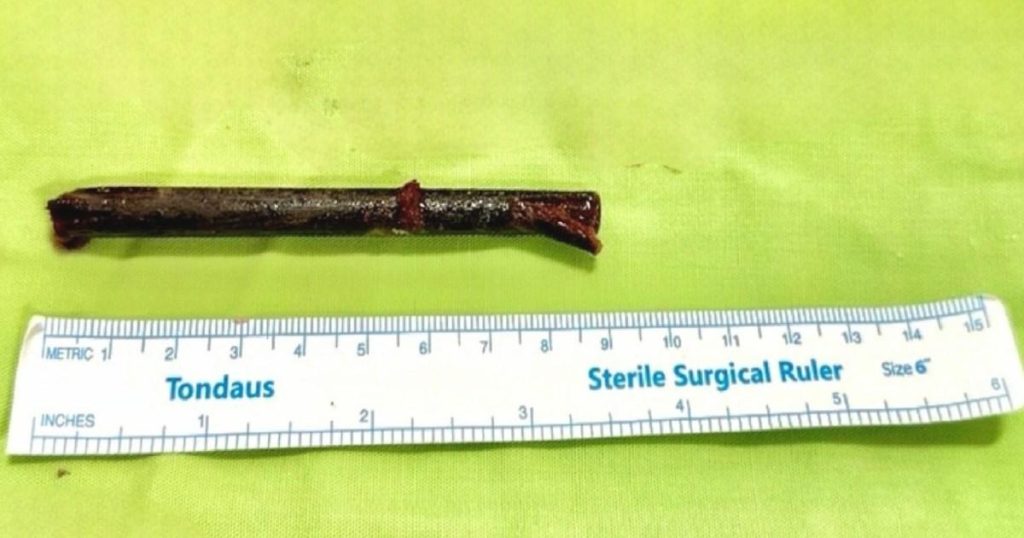This case study details the unusual and alarming medical journey of a 24-year-old man in Vietnam who inadvertently lodged a 9cm-long chopstick behind his eye socket. The incident occurred during a drunken encounter with a friend, highlighting the potential for unforeseen accidents under the influence of alcohol. Initially, the man experienced swelling around his eye and sought medical attention at a local medical center. However, despite three weeks of observation and examination, the medical staff failed to identify the presence of a foreign object. This delay in diagnosis underscores the challenges in diagnosing injuries when the cause isn’t readily apparent and the importance of advanced imaging techniques in complex cases.
The man’s condition persisted, prompting a visit to a hospital where a CT scan finally revealed the culprit – a chopstick lodged deep within his nasal passage, extending into the orbital area behind his eye. The CT scan, a crucial diagnostic tool, provided a clear visualization of the chopstick’s location and the extent of its intrusion, information that was crucial for planning the appropriate surgical intervention. The medical report, published in the Journal in Oral and Maxillofacial Surgery Cases, describes the patient’s symptoms as pain and swelling in the left orbit, accompanied by pus discharge from the corner of the eye. Remarkably, the patient retained full vision and exhibited no signs of global eye injury. This suggests that the chopstick, while deeply embedded, miraculously avoided critical structures within the eye itself.
The discovery of the chopstick necessitated immediate surgical removal. The procedure not only addressed the removal of the foreign object but also focused on repairing any damage caused to the bottom of the patient’s eye. This emphasizes the delicate nature of the orbital area and the potential for complications arising from the presence of a foreign body. Following the surgery, the patient received a course of antibiotics to combat any potential infection. The medical report rightly highlights the risk of infection associated with the chopstick, given its unclean state from being used during a meal. The presence of a contaminated foreign body in such a sensitive area significantly increases the risk of bacterial contamination and subsequent infection within the maxillary sinus and orbit.
This case serves as a stark reminder of the unpredictable nature of accidents, particularly those occurring under the influence of alcohol. It also highlights the importance of thorough medical investigation and the use of appropriate diagnostic tools, such as CT scans, in cases where the cause of symptoms remains elusive. The initial misdiagnosis at the local medical center underscores the need for vigilance and the consideration of less obvious possibilities when initial examinations yield no clear answers. Had the CT scan been performed earlier, the patient could have avoided three weeks of discomfort and potential complications. This delay, while unfortunate, reinforces the value of advanced imaging in complex medical scenarios.
Furthermore, this case emphasizes the potential for seemingly innocuous objects to cause significant harm when introduced into the body, especially in delicate areas like the eye socket. The chopstick, a common utensil, became a dangerous instrument in this instance, illustrating the unexpected ways in which everyday objects can become hazardous under specific circumstances. The emphasis on the chopstick being used during a meal before the incident also highlights the importance of hygiene and the potential for contamination when foreign objects enter the body. This underscores the need for prompt medical attention and appropriate infection control measures, such as the administration of antibiotics, in such cases.
Finally, this case study provides valuable insights for medical professionals in diagnosing and managing similar cases involving foreign objects lodged in the head and neck region. It underscores the importance of considering unusual causes of facial swelling and pain, particularly in patients with a history of recent trauma or unusual incidents. The case also highlights the effectiveness of CT scans in identifying foreign bodies and guiding surgical interventions. The successful removal of the chopstick and the patient’s subsequent recovery serve as a testament to the advances in medical technology and surgical techniques, emphasizing the importance of prompt and appropriate medical intervention in such cases.




